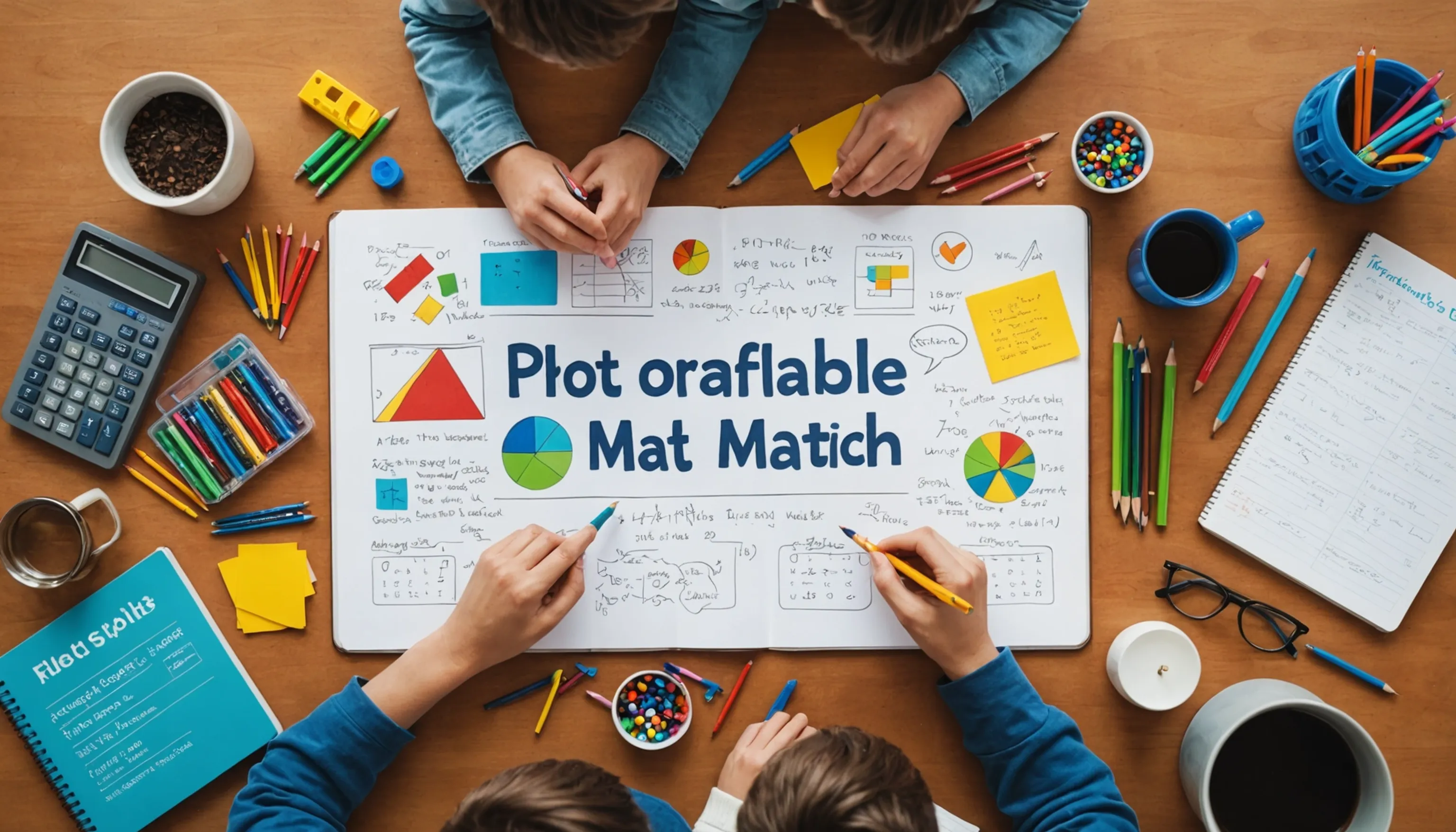Affordable Math Tools for Homeschooling
 HvWHenry van Wagenberg
HvWHenry van Wagenberg
Affordable Math Tools for Homeschooling Teens
Homeschooling teens can be a rewarding experience, especially when you have access to affordable math tools. These tools not only make learning math enjoyable but also fit within a budget. Popular options include online platforms, printable worksheets, and educational apps.
By choosing budget-friendly resources, parents and teachers can create a rich learning environment. Many tools offer interactive exercises, allowing students to practice at their own pace. Moreover, combining various tools—like apps and traditional worksheets—can enhance understanding and retention of mathematical concepts, making learning both effective & affordable.
Top Budget-Friendly Math Tools
Finding budget-friendly math tools for homeschooling can significantly enhance the learning experience for teens. Here are some of the top options that won't break the bank:
- Online Platforms: Websites like Khan Academy and IXL offer free or low-cost math courses that cover a wide range of topics. These platforms provide interactive lessons and practice exercises tailored to different skill levels.
- Printable Worksheets: Many websites offer free downloadable worksheets. Sites like Education.com and Teachers Pay Teachers have a vast collection of math worksheets that cater to various topics and difficulty levels.
- Math Apps: There are numerous affordable apps available for smartphones and tablets. Apps like Photomath and Mathway allow students to take pictures of problems and receive step-by-step solutions, making math more accessible.
- Workbooks: Look for budget-friendly workbooks at local bookstores or online retailers. Many publishers offer comprehensive workbooks that align with curriculum standards at a reasonable price.
- Homeschool Co-ops: Joining a local homeschool co-op can provide access to shared resources and tools, often at a lower cost than purchasing individually.
Incorporating a mix of these affordable math tools can create an engaging and comprehensive math learning environment. By leveraging various resources, parents and teachers can ensure that their teens develop a strong foundation in mathematics while managing costs effectively.
Online Resources for Math Learning
Utilizing online resources for math learning has become increasingly popular among homeschooling families. These resources provide flexible, interactive, and engaging options for students to enhance their mathematical skills. Here are some standout choices:
- Khan Academy: This widely recognized platform offers free courses covering math topics from basic arithmetic to advanced calculus. With instructional videos and practice exercises, students can learn at their own pace, making it an invaluable resource for teens.
- IXL: While IXL requires a subscription, it offers a comprehensive math curriculum with personalized learning paths. The adaptive technology adjusts the difficulty level based on student performance, ensuring that learners are always challenged.
- Mathway: This app provides instant solutions to math problems across various topics. Students can input their questions and receive detailed explanations, helping them understand the concepts behind the solutions.
- Prodigy: An interactive math game that makes learning fun, Prodigy combines gaming with curriculum-aligned math challenges. It's free to use, with optional premium features, making it an engaging way to practice math skills.
- Desmos: Ideal for high school students, Desmos is a graphing calculator that allows users to visualize mathematical concepts easily. It's an excellent tool for algebra, geometry, and calculus.
Incorporating these online resources into a homeschooling curriculum can foster a love for math while providing essential support for students as they navigate challenging concepts.
Printable Worksheets and Workbooks
Printable worksheets and workbooks are invaluable tools for homeschooling parents and teachers looking to provide structured practice for math concepts. They offer a flexible and convenient way to reinforce learning outside of traditional online platforms. Here are some key points to consider:
- Diverse Topics: Printable worksheets cover a wide range of math topics, from basic addition and subtraction to more advanced algebra and geometry. This diversity allows parents to choose materials that align with their child’s current curriculum and learning needs.
- Customizable Learning: Parents can select specific worksheets based on their teen's proficiency level, ensuring that the challenges are neither too easy nor too difficult. This customization helps maintain engagement and motivation.
- Variety of Formats: Worksheets can come in various formats, including multiple-choice questions, word problems, and fill-in-the-blank exercises. This variety caters to different learning styles, making math practice more enjoyable.
- Easy Access: Many educational websites offer free downloadable worksheets, such as Education.com, Teachers Pay Teachers, and Math-Drills.com. These resources make it easy for parents to find and print materials without incurring high costs.
- Workbook Series: Investing in comprehensive workbook series can provide a structured approach to math learning. Workbooks typically contain explanations, examples, and practice problems that guide students through concepts step by step.
By incorporating printable worksheets and workbooks into a homeschooling routine, parents can ensure their teens receive ample practice while fostering a solid understanding of mathematics.

Math Apps for Affordable Learning
Math apps are an excellent solution for affordable learning in homeschooling environments. These apps provide interactive and engaging ways for teens to practice math concepts at their own pace. Some popular options include:
- Photomath: This app allows students to scan math problems and receive step-by-step solutions, promoting understanding.
- Mathway: Offering instant answers and explanations, it covers various topics from algebra to calculus.
- Khan Academy: A comprehensive resource with a mobile app, it provides lessons and practice exercises for free.
These tools make math learning accessible and enjoyable without straining the budget.
Best Free and Low-Cost Math Apps
When it comes to finding the best free and low-cost math apps, there are numerous options available that cater to different learning styles and needs. These apps can enhance the homeschooling experience for teens by providing interactive and engaging ways to learn math concepts. Here are some top recommendations:
- Khan Academy: Completely free, this app offers a comprehensive library of instructional videos, practice exercises, and personalized learning dashboards. It covers a wide range of topics, from basic arithmetic to advanced calculus, making it suitable for various ages and skill levels.
- Photomath: This innovative app allows students to take pictures of math problems and receive step-by-step solutions. It helps them understand the processes behind solving equations, making it a valuable tool for homework help.
- Mathway: Available for both free and premium versions, Mathway provides instant solutions to a wide array of math problems. The app covers subjects from algebra to statistics and offers explanations to help students grasp concepts.
- Prodigy Math: This game-based app makes math practice fun and engaging. While the basic version is free, it offers in-app purchases for additional features. Prodigy adapts to each student's learning pace, making it an excellent tool for personalized learning.
- Microsoft Math Solver: A free app that allows users to scan or type in math problems and receive detailed solutions. It also offers video explanations and practice problems.
By integrating these free and low-cost math apps into their learning routine, parents and teachers can provide a rich educational experience that keeps teens motivated and engaged.
How to Use Math Apps Effectively
Using math apps effectively can greatly enhance the learning experience for teens. To maximize the benefits of these digital tools, consider the following strategies:
- Set Clear Goals: Before starting, establish specific learning objectives. Whether it's mastering a particular concept or improving problem-solving skills, having clear goals helps students stay focused.
- Choose the Right App: Different apps cater to various learning styles and needs. Explore options like Khan Academy for comprehensive lessons, Photomath for homework help, and Prodigy for engaging game-based learning. Selecting the right app ensures a tailored approach to learning.
- Encourage Regular Practice: Consistency is key in math learning. Encourage students to set aside dedicated time each day or week to use math apps. Regular practice helps reinforce concepts and builds confidence.
- Monitor Progress: Many math apps offer tracking features that allow students to see their progress. Regularly review this data to identify areas needing improvement and celebrate milestones to keep motivation high.
- Supplement with Traditional Methods: While apps are excellent tools, they should complement traditional learning methods. Use worksheets, textbooks, or group study sessions alongside apps to provide a well-rounded educational experience.
- Seek Help When Needed: Encourage students to ask questions or seek help from parents or teachers if they encounter difficulties. Understanding concepts is crucial for long-term success.
By implementing these strategies, students can leverage math apps effectively, leading to improved understanding and performance in mathematics.
Benefits of Math Apps for Teens
Math apps offer numerous benefits for teens, enhancing their learning experience in several ways. Firstly, these apps provide interactive and engaging content that makes math more enjoyable. This gamification element encourages students to practice regularly without feeling overwhelmed.
Secondly, math apps often feature personalized learning paths. They adapt to each student's skill level, ensuring that the material is neither too easy nor too challenging. This tailored approach promotes confidence and mastery of concepts.
Moreover, many math apps include instant feedback, allowing teens to identify mistakes and learn from them in real-time. This immediate reinforcement helps solidify understanding.
Additionally, math apps can be accessed anywhere and anytime, offering flexibility for busy schedules. This convenience allows students to practice math on the go, maximizing learning opportunities. Overall, the use of math apps can significantly enhance both understanding and interest in mathematics.

Engagement and Motivation Through Apps
Engagement and motivation are crucial factors in effective learning, and math apps excel at fostering both among teens. One of the primary ways these apps achieve this is through gamification. By incorporating game-like elements such as rewards, levels, and challenges, math apps make learning enjoyable. Students are more likely to engage with the material when they can earn points or unlock achievements, turning math practice into a fun activity.
Additionally, many math apps feature interactive lessons that require active participation. This hands-on approach not only keeps students engaged but also promotes a deeper understanding of mathematical concepts. For example, apps that use visual aids, such as graphs and animations, help students grasp complex topics more easily.
Furthermore, math apps often allow for self-paced learning. Teens can progress through exercises at their own speed, which reduces anxiety and builds confidence. This autonomy empowers students to take ownership of their learning journey.
Social features in some apps also enhance motivation. By allowing students to compete with friends or collaborate on challenges, these apps create a sense of community and accountability. This social interaction encourages teens to stay motivated and committed to their math studies.
Overall, by leveraging gamification, interactivity, and social elements, math apps effectively boost engagement and motivation, making math learning a positive experience for teens.
Tracking Progress with Math Tools
Tracking progress with math tools is essential for understanding a student's growth and identifying areas needing improvement. Many math apps and online platforms offer built-in analytics that help parents and teachers monitor a teen's performance over time.
Firstly, these tools typically provide detailed reports on completed exercises, accuracy rates, and time spent on various topics. By analyzing this data, parents can identify patterns in learning, such as which concepts are mastered and which require additional practice. For example, if a student consistently struggles with fractions, targeted intervention can be implemented to address this gap.
Secondly, tracking progress fosters accountability in students. When teens can see their achievements and areas for growth, they become more motivated to set goals and work towards them. Many apps also allow students to earn badges or rewards for milestones achieved, reinforcing positive behavior and encouraging continuous effort.
Moreover, regular progress checks can facilitate meaningful discussions between parents and teens. These conversations provide an opportunity to celebrate successes and address challenges together, making the learning experience more collaborative.
Lastly, by keeping track of progress, educators can adjust their teaching strategies to better meet the individual needs of each student. Whether through personalized lesson plans or additional resources, adapting to a student's progress ensures a more effective learning environment.
In summary, utilizing math tools to track progress not only enhances understanding but also boosts motivation, accountability, and collaboration in the learning process.
Combining Tools for Comprehensive Learning
Combining various math tools for comprehensive learning is essential for a well-rounded educational experience. By integrating online resources, printable worksheets, and math apps, parents can create a dynamic learning environment for their teens. For instance, online platforms can introduce new concepts, while printable worksheets provide practice and reinforcement. Math apps can engage students with interactive challenges, making learning enjoyable.
This multi-faceted approach addresses different learning styles, ensuring that students grasp concepts effectively. By leveraging multiple resources, teens can develop a deeper understanding of mathematics, making their learning experience both engaging and effective.
Integrating Different Math Resources
Integrating different math resources is crucial for creating a comprehensive and effective learning environment for teens. By combining various tools—such as online platforms, printable worksheets, and educational apps—parents and teachers can cater to diverse learning styles, ensuring that each student receives a well-rounded educational experience.
Firstly, online platforms like Khan Academy or IXL provide structured lessons and practice problems, making them excellent starting points for introducing new concepts. These platforms often feature interactive elements that engage students and allow them to learn at their own pace. Following online instruction, printable worksheets can reinforce the concepts taught, providing students with the opportunity to practice independently and solidify their understanding.
Additionally, incorporating math apps adds another layer of interactivity and fun. Apps like Prodigy or Photomath not only make learning enjoyable but also offer instant feedback, helping students recognize mistakes and learn from them in real time. This immediate reinforcement is essential for building confidence in mathematical skills.
Moreover, utilizing resources like video tutorials or math-focused YouTube channels can supplement traditional methods and provide varied explanations of complex topics. This variety ensures that if one approach doesn’t resonate with a student, another might.
Finally, regular assessments and progress tracking help in identifying areas that need more focus. By integrating these diverse resources, students can develop a deeper understanding of mathematics while remaining engaged and motivated throughout their learning journey.
Creating a Balanced Math Curriculum
Creating a balanced math curriculum for homeschooling teens involves integrating various teaching methods and resources to address diverse learning styles and ensure comprehensive understanding. A well-rounded curriculum not only covers essential mathematical concepts but also fosters engagement and critical thinking.
To begin, it’s essential to outline the core topics to be covered, such as arithmetic, algebra, geometry, and statistics. Each topic should be approached with a combination of instruction methods, including direct teaching, interactive lessons, and hands-on activities. For instance, starting with online platforms like Khan Academy can introduce new concepts through engaging videos and interactive exercises.
Once foundational concepts are established, printable worksheets can be used to reinforce learning. These worksheets should vary in difficulty and format, including multiple-choice questions, word problems, and practical applications. This variety helps keep students engaged while allowing for practice in different contexts.
Incorporating math apps adds an element of fun and interactivity. Apps like Prodigy and Photomath provide immediate feedback and gamified learning experiences, making it easier for teens to stay motivated.
Additionally, regular assessments, both formal and informal, are crucial for tracking progress and identifying areas needing further attention. These assessments can include quizzes, project-based learning, and discussions to assess understanding.
Finally, fostering a growth mindset is vital. Encouraging students to embrace challenges and learn from mistakes creates a positive learning environment. By combining various resources and approaches, parents can create a balanced math curriculum that equips teens with the skills and confidence needed for future success.
